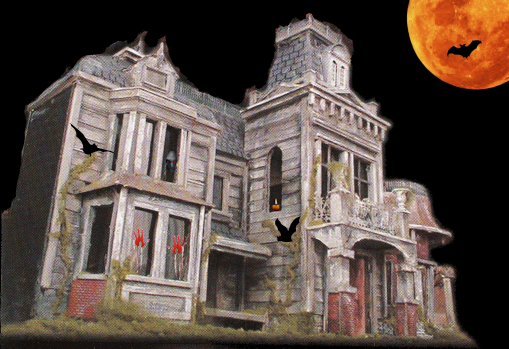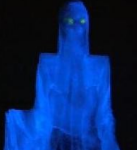Historical Origin Of Halloween
Just about every culture sets aside a special time to remember those who have died and give reverence to departed ancestors.
Halloween started out as that kind of celebration. It has mutated since it came to America. The Mexican version of Halloween is Dia De Los Muertos, Day of the Dead.
Religious Origin
Halloween started out as a religious festival of the Celtic people. When “Celts” are mentioned, one often thinks first of the Irish, but technically England, Scotland, Wales, France, and Germany are all Celtic in origin.
This Pagan religious festival celebrated Samhain, the end of the harvest season. “Samhain” is Gaelic (Celtic language) for “end of Summer”. [The “m” is silent. The word is pronounced “sowin”.
Some ill-informed people believe that Halloween celebrates “Sam Hain, God Of Evil” This is completely untrue. Anybody who says this is such a poor scholar that you can’t really trust anything else they tell you.
Samhain was also the end of the Celtic calendar, and a time to reflect on what had happened in the year and loved ones who had passed on.
When England and Ireland was Christianized by the Catholic church, evangelists took care to point out the similarities between the old and new religions. [Ours new religion is just like the old one, but new and improved!] They built churches on holy Pagan sites, and moved Christian holidays to the corresponding Pagan celebrations. [Have you ever wondered why Christmas is celebrated in December, while the Bible suggests that Jesus was born in the spring?]
The Catholic Church designated the following holidays:
- November 2 – All Souls’ DayRememberance of all the dead.
- November 1 – All Saints’ DayRemembrance of the dead who found special favor with God. Since saints = holy people = hallowed, All Saints’ Day is also known as All Hallows’ Day.
- October 31 (night) – HalloweenThe evening before All Hallows’ Day was called All Hallows’ Eve, which was shortened to “Halloween”.
Celtic immigrants brought Halloween to America, but it didn’t take root until the mass Irish immigrations in the 1840s. In America, Halloween lost most of the religious aspects, increased the trick-or-treating, and was given more sinister overtones by German fears of witches spreading mischief on Walpurgisnacht (which is actually May 1, but what the heck). Americans also started making Jack o’Lanterns out of pumpkins, instead of the traditional turnips.
Trick Or Treat!
The Celts believed that there is a material world that we live in, and a supernatural world occupied by strange creatures, gods, elves, and the spirits of the dead. Twice a year (end of February and end of October), the borders between these worlds become thin, and you can pass between the worlds.
The Celts thought that, on the night of October 31, supernatural creatures would pass through the veil between worlds and would walk our world.
Some people feared that ghosts and magical creatures might cause trouble. So the people dressed up in costumes. Some believed that the costumes would frighten away the creatures. Others believed that the magical creatures would be fooled into thinking that the costumed people were also magical – and leave them alone.
The Celts also left out donations of food and fruit on their doorsteps. Some hoped that this would attract good spirits. Others thought that it would satisfy bad spirits and make them go away.
Over time, the two traditions of costumes and food turned into the tradition of children dressing up in costume to ask for candy. Pretending to be magical creatures, they threaten to play a trick on you, unless you give them an offering – “Trick or Treat!”
“Sam Hain”, God Of Evil!
A lot of people have strong opinions about Halloween but are ignorant of the facts. One particularly silly belief is that Halloween celebrates “Sam Hain”, a “God Of Evil” or “God Of Death.” People like that usually pronounce “Samhain” as “Sam Hain”.
- The ancient Celts did not have a deity named “Samhain” or “Sam Hain.”
- Unlike Greek and Roman mythology, the Celts did not have a god of death, the dead, or the underworld.
- The ancient roots of Halloween did not include worship of death, a god of death, evil, or a god of evil.
- The ancient Celts had many deities, some of whom were nicer than others, some of whom were unpleasant, and some of whom were mischevious or capricious.
- The ancient Celts celebrated Samhain as a festival marking the last harvest.
- Ancient Samhain/Halloween did include remembrance of those who had died during the year and prayers for the departed.
For more information on the derivation of the name “Samhain”, please see Wikipedia’s article http://en.wikipedia.org/wiki/Samhain.
Halloween Today
Commercial Halloween
Like other holidays, Day of the Dead and Halloween have developed into secular holidays, and acquired a crass commercial overlay.
There are many who still remember and cherish the religious traditions of Halloween. But to most people in modern America, Halloween is just a time when kids can run through the streets in costumes, demanding candy and treats from their neighbors.
For adults, Halloween is increasingly turning into a time when they get to dress up and party.
Dia De Los Muertos
Dia De Los Muertos, the Mexican Day of the Dead, is celebrated November 1-2.
Like other holidays, Day of the Dead has developed into a secular holiday, and acquired a crass commercial overlay. But private observance tends to maintain a lot of the reverence. Altars are sometimes set up at home to remember the dead. Visits are often made to graveyards, bringing decorations including flowers and decorated skulls made from sugar. It is not unusual to hold picnics in the graveyard, at the final resting place of ancestors.
Some Day of the Dead folk art uses skeletons and skulls in everyday scenes: wearing hats, playing instruments, walking the dog, getting married. It’s a healthy reminder that death comes to everybody and you shouldn’t worry too much about it.
Mexican sugar skulls come in all sizes. Many are decorated with colorful icing.
For More Details, Go To The References and Sources Below:
- Rogers, Nicholas (2002). “Samhain and the Celtic Origins of Halloween”. Halloween: From Pagan Ritual to Party Night, pp.11–21. New York: Oxford University Press. ISBN 0-19-516896-8
- Roger, Nichola (2002). Halloween: From Pagan Ritual to Party Night. Oxford University Press. pp. 28–30. ISBN 0-19-514691-3.
- Arnold, Bettina (2001-10-31). “Bettina Arnold – Halloween Lecture: Halloween Customs in the Celtic World” . Halloween Inaugural Celebration. University of Wisconsin–Milwaukee: Center for Celtic Studies. http://www.uwm.edu/~barnold/lectures/holloween.html . Retrieved 2007-10-16.
- Skal, David J. (2002). Death Makes a Holiday: A Cultural History of Halloween, p.34. New York: Bloomsbury. ISBN 1-58234-230-X.
- http://www.horrorseek.com/



